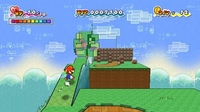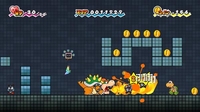|
If there could only be one iconic figure in gaming, it would be that mustachioed master of midair maneuvering, Mario. His popularity has spanned the globe and he has become a household name, with fans even going so far as to nickname his creators the "Mario Factory." While Mario has made appearances in several franchises, two in particular have gained the largest following: his classic Super Mario Bros. platforming adventures, and his role-playing Paper Mario stories. Super Paper Mario combines his two past-times into an experience that is not only unique, but quite possibly his greatest game to date.
Super Paper Mario begins, in traditional fashion, with Princess Peach being kidnapped. One trip to Bowser's castle later, however, reveals that it was not Mario's archenemy who perpetrated this nefarious deed, (he was only in the planning stages) but a new villain named Count Bleck, who also takes Luigi and even Bowser himself. Mario soon finds himself in a town called Flipside, where he teams up with Tippi, a fairy-like creature called a Pixl, to track down the eight Pure Hearts and save all the worlds from certain doom.
 Catch ya on the flipside, Mario!
Catch ya on the flipside, Mario!
|
|
The story is simple, but told brilliantly, with lots of humor, general silliness, and even a few legitimately emotional scenes thrown into the mix. The localization is impeccable; the dialogue flows so well that it's nearly impossible to tell the game was ever in Japanese at all.
Combat in Super Paper Mario is a strange hybrid of traditional Super Mario Bros. platforming and standard RPG conventions. Much like the earliest NES and SNES games, worlds are side-scrolling platforming adventures, with attacks being delivered via a satisfying stomp to the head. However, with the addition of health and attack power, as well as three additional playable characters, the game manages to be far more forgiving than its inspirations, and also allows for enemies and boss battles that would simply be impossible in a traditional platforming game. For example, falling in a pit won't end your game, rather you'll simply lose some HP, and likewise should you be struck by an enemy.
What really sets it apart, though, is Mario's unique ability to "flip" from 2-D into 3-D, allowing the player to access hidden areas and bypass obstacles that would otherwise be insurmountable. The other three characters you acquire also have unique abilities, as do the numerous Pixls you'll acquire throughout the course of the game, which provide several useful powers to help you on your journey. Mario will also collect several items along the way, which can restore health, reduce damage, and even attack enemies. There's even a restaurant in which items can be cooked to prepare dishes that restore more health than their ingredients.
 Bowser killing Goombas?! What in the world?
Bowser killing Goombas?! What in the world?
|
|
Despite being developed for Nintendo's new motion-sensitive system, Super Paper Mario takes a very traditional approach at controls. In fact, it brings the classic NES controller to mind, as the entire game is played by flipping the Wii remote on its side. While this might seem odd at first, it is, in fact, remarkably effective. The motion sensitive controls of the Wii are still used to some extent - you can point it at the screen to have Tippi examine the area and sometimes uncover invisible objects, and a number of special items require you to shake or tilt the remote just so - but for the most part, the game is played in this classic mode.
Blending the RPG and Platforming genres is something that has been attempted before in games such as Valkyrie Profile and Wild ARMs 4, but never has it managed to be so elegantly simple and deliciously enjoyable as in Super Paper Mario. The merging of the two game styles provides a unique experience that manages to surpass those provided by each on its own.
Visually, the game once again blends elements from both the Super Mario Bros. series as well as Paper Mario. Virtually everything in the game, from the characters to the backdrops, is perfectly flat like a sheet of paper (and this even manages to become part of the gameplay). However, levels are designed much akin to those seen in the NES and SNES games, with floating blocks, scrolling parallax backgrounds, and lots and lots of pipes. Everything in general has a very cartoony style, as would be expected from a Mario game, but the unique combination of 2-D and 3-D artwork provides something new and exciting.
Super Paper Mario features a bright, peppy soundtrack filled with tunes both new and old. Fans of previous Mario games will easily recognize several of the remixed tracks of their favorite pieces. It is unfortunately lacking in voicework, but makes up for it with a superb use of sound effects. While most of these effects are new, a few nostalgic pieces, such as the classic jump effect from the NES games, return for short cameo appearances.
If one had to fault Super Paper Mario for anything, it's simply that the game is too short. Winding up at around 20 hours total, the game is over far too quickly. There are a number of optional challenges and side-quests available for those players who wish to attempt them, including a pair of 100-floor dungeons and a massive collection of special character cards (which, interestingly, provide attack bonuses against the enemies depicted on them). Despite its disappointing length, Super Paper Mario is one of the most original, creative, and fun games to be released in years, and should definitely not be missed.
Review Archives
|









